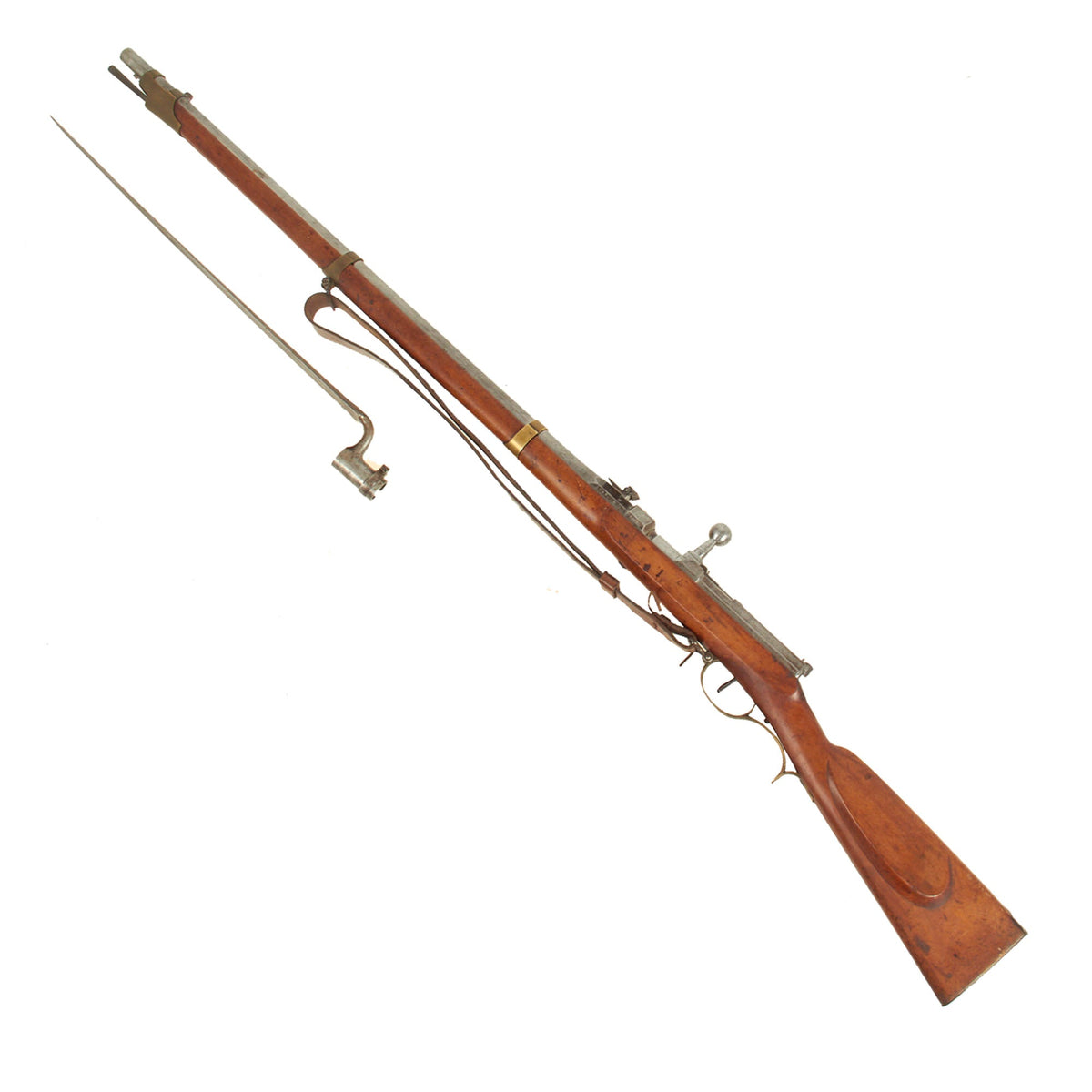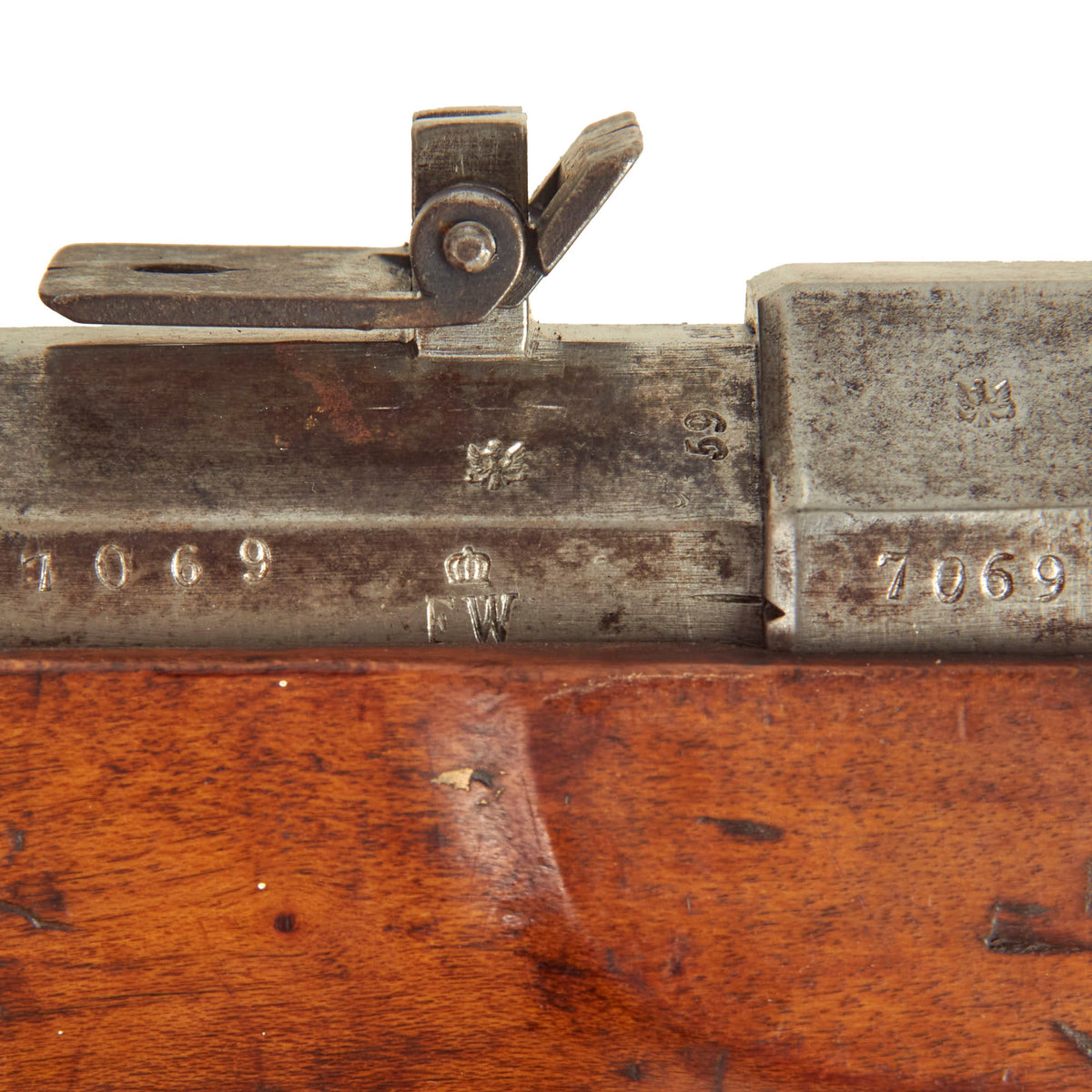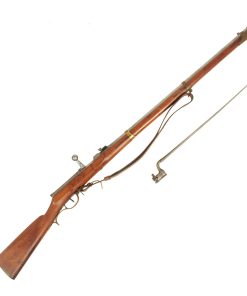Original German Dreyse Zündnadelgewehr M/41 Needle Fire Rifle Serial 7069 with “Duffle Cut” & Bayonet – dated 1859 Original Items
$ 3.995,00 $ 998,75
Original Item: Only One Available. These are exceedingly hard to find in any condition, especially the long rifles! The German states were apparently very good with “recycling” their obsolete weapons, and did not have any “Colonial Empire” to speak of until after 1884, which is where obsolete weapons were sent by other Colonial powers. We have only had two examples of Dreyse needle fire guns before, and they were manufactured decades later. This example looks to have seen very little use, and was most likely hanging on a wall for decades, probably until WWII, when one of many USGI’s in Germany brought it back home.
Unfortunately, the best evidence we have for this journey is a very clean “Duffle Cut” through the stock under the lower barrel band. This was a common thing to see on USGI bring back rifles, as they would take the barrel and receiver out of the stock, and then cut the stock in half so it would fit into a Duffle bag or crate. This also meant that it would still display just fine once reassembled. The rifle comes with an original bayonet, and also was fit long ago with a British 1941 dated leather Enfield sling, probably acquired during the trip home. Everything points to this being a rifle that escaped being obsoleted and became a USGI WWII Bring back.
This is a nice example of what we believe is the original long Zündnadelgewehr Modell 1841 (M/41) Needle Fire Rifle, which is marked Soemmerda N D / Mod: 41 on the left side of the receiver, for manufacture at Nikolaus von Dreyse‘s factory in Sömmerda, Germany. He started the factory together with his son Franz, and apparently some years after inventing the Needle-fire system, dropped the “Johann” from the front of his name. The right side of the receiver bears a manufacture date of 1859, which matches that on the butt plate. It fits the pattern exactly except for the lovely carved cheek piece on the left side of the butt stock, possibly indicating issue to some type of sharpshooter unit.
The rifle is marked with serial number 7069 on the receiver, barrel, bolt, and butt plate, with only the needle holder at the end of the bolt being non-matching. This component is easily and often swapped out, as it is faster than replacing the needle itself. Under the sight it has the CROWN / FW Royal Cypher of Prussian King Friedrich Wilhelm IV, who reigned 1840 to 1861. His son, King Wilhelm I, would go on to become the first Kaiser (Emperor) of the German Empire. There are also lots of other German proof and acceptance markings on the metal components of the rifle. The butt plate tang is marked 20. L. II. 4. 27., which we assume is for one of the “Landwehr” infantry regiments.
The metalwork on the rifle shows a lovely light gray color, faded from the original bright steel. It has a nice original steel cleaning rod, with an intact cleaning jag on the other end. Please note that it is quite difficult to remove from the rifle at present, and needed a lot of back an forth movement to pull it. The bayonet fits as well, but also requires use of a rubber mallet to get it into place properly. The bolt can still be removed from the rifle, though the trigger must be pulled back VERY far. Inspection shows that the steel portion of the needle was cut off about half an inch past the brass holder, so it doesn’t even come close to the breech face anymore.
Aside from the “Duffle Cut”, the stock is really in nice condition, showing a lovely honey color, and does not look to have been messed with or abused during its long life. Looking under the barrel bands shows no evidence of having been through any type of major refurbishment at arsenal at any time. Overall it has a lovely warm glow, showing light signs of use.
These are incredibly rare, and this is the first example that we have seen in quite some time. From looking around these are very seldom encountered, especially with the bayonet! Ready to research and display!
Specifications (Rifle):-
Year of Manufacture: circa 1859
Caliber: 15.4mm Dreyse
Cartridge Type: Needlefire Cartridge – Lead bullet in Paper Cartridge
Barrel Length: 35 1/2 inches
Overall Length: 56 Inches
Action type: Bolt-Action Needle Fire
Feed System: Single Shot
Specifications (Bayonet):-
Blade Length: 19″
Blade Style: Triangular
Socket Length: 2 1/8″
Overall length: 21 1/2
In 1836 JOHANN NIKOLAUS VON DREYSE designed this breech loading cartridge system while the rest of the world were still using muzzleloaders. Indeed, the original prototypes were muzzle loaders themselves, but continued development led to the adoption of a bolt-action system. These were called Zündnadelgewehr, which translates roughly as “ignition needle rifle”. After successful testing in 1840, the Prussian king Friedrich Wilhelm IV ordered 60,000 of the new rifles. Dreyse set up the Dreyse-Zündnadel factory in Sömmerda with the help of state loans to ramp up production. These were adopted by the Prussian Military in 1841, and called the Leichtes Perkussionsgewehr Modell 1841 (“light percussion rifle Model 1841”), with the name chosen to hide the revolutionary nature of the new weapon.
Its first notable service was in the May uprisings in Dresden in 1849. Taking a 15.4mm paper cartridge ignited by a needle projecting from the front of the bolt, the barrel on these is heavily rifled to engage the cartridge. The system was so revolutionary that it was observed that in the Austro-Prussian War of 1866, a Prussian Infantryman could fire five rounds from a prone position in the time it took an Austrian Infantryman to discharge one round from a standing position.
The Zündnadel saw service up through the Franco-Prussian War of 1870-1871, when the Prussians were quickly victorious despite the French Chassepot Needle fire Rifle introduced in 1866, which was considered a far superior weapon. It was this action that brought the German Empire together in 1871, and by this time the Needle Rife rifles were in use by many other German states. The Dreyse Needle Fire was obsoleted in 1871 with the introduction of Paul Mauser’s M1871 bolt action rifle which took what we would think of as conventional brass cased ammunition (10.4mm).
Franz von Dreyse had developed a self-cocking modification to the firing system, almost as a last ditch attempt to prolong the service life of the needle fire design. This allowed for a few more smaller contracts to be won by the factory, which would later go on to produce other standard arms for the German military and others. The father and son had started a gun factory in Sömmerda together, which Franz continued after his father passed in 1867, until his own passing in 1894.
NOTE: International orders of antique firearms MUST be shipped using UPS WW Services (courier). USPS Priority Mail international will not accept these. International customers should always consult their country’s antique gun laws prior to ordering.
Fast Shipping with Professional Packaging
Thanks to our longstanding association with UPS FedEx DHL, and other major international carriers, we are able to provide a range of shipping options. Our warehouse staff is expertly trained and will wrap your products according to our exact and precise specifications. Prior to shipping, your goods will be thoroughly examined and securely secured. We ship to thousands clients each day across multiple countries. This shows how we're dedicated to be the largest retailer on the internet. Warehouses and distribution centres can be located throughout Europe as well as the USA.
Note: Orders with more than one item will be assigned a processing date depending on the item.
Before shipping before shipping, we'll conduct a thorough inspection of the items you have ordered. Today, the majority of orders will be delivered within 48 hours. The delivery time will be between 3-7 days.
Returns
The stock is dynamic and we cannot completely manage it because multiple stakeholders are involved, including our factory and warehouse. So the actual stock may alter at any time. It's possible that you may not receive your order once the order has been made.
Our policy is valid for a period of 30 days. If you don't receive the product within 30 days, we are not able to issue a refund or an exchange.
You can only return an item if it is unused and in the same state as the day you received it. You must have the item in its original packaging.
Related products
Uncategorized
Uncategorized
Uncategorized
Uncategorized
Uncategorized
Australian WWII Owen MK1 Machine Carbine SMG Custom Fabricated Replica with Sling Original Items
Uncategorized
Uncategorized
Uncategorized
Angolan Rebel 1970s era 60mm Inert Display Mortar from Angolan Civil War Original Items
Uncategorized
Uncategorized
Uncategorized
Armored Burgonet Helmet & Polearm from Scottish Castle Leith Hall Circa 1700 Original Items
Uncategorized
Uncategorized
Armoured Fighting Vehicles of the World: AFVs of World War One (Hardcover Book) New Made Items
Uncategorized
Uncategorized












































































